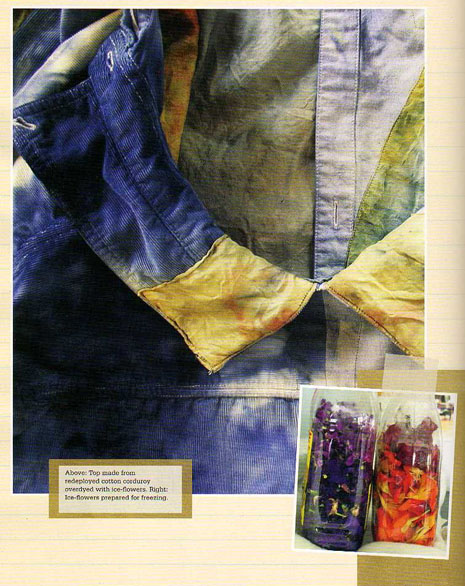Book Review:
Eco colour, commences in the traditional manner with a brief The chapter on mordants begins the really intriguing part of the book. India has researched a range of mordants: protein-based, from plants, acids and alkalis—some of which may be new to the average dyer (such as corn flour, egg white, blood or gelatine). The next chapter on processing plant dyes is another revelation, with excellent details on a range of dye applications, including solar dyeing, compost dyeing, bundling, and beating techniques as well as the more traditional methods. The following chapter on ice-flower dyes is fascinating and opens up a new process for many of us. My freezer will be filled with frozen blossoms to experiment with this procedure. India is known for her work with eucalypt dyeing, often using bundled processes, and there is a great deal of information on both bundling and wrapping using eucalypts and metal objects to provide mordants and patterns. Eco colour is copiously illustrated and concludes with an excellent bibliography and an interesting list of Web sites specific to fabric dyeing, dyes and cloth. The importance that India places on reducing the use of chemicals is exemplified in the production of this very beautiful book, which is printed on 100% recycled paper (both white and brown) using soy-based inks. This book is a significant and inspirational addition to the literature on natural dyeing and one which must be read by anyone interested in the topic. Pam Borchardt is a member of the Natural Dye Group, Plant Craft Cottage, Royal Botanic Gardens, Victoria, Australia India Flint
India Flint, Eco colour:
botanical dyes for beautiful textiles
by Pam Borchardt
history of dyeing and then covers finding dye materials in sources as disparate as the back yard or the greengrocer, harvesting and storing dye materials and a list of dye materials. Interspersed throughout are fascinating stories of her family background and the tips on processing dyes while travelling.
Another dye book—there are so many, surely the topic has been covered. But no—here is a significantly different book that all those interested in natural dyeing must read. India Flint has been working with plant dyes for many years and has developed a range of techniques which are based on her passionately-held concerns with the environment and the dangers of chemical residues.


Eco colour: Botanical dyes for beautiful textiles
Hardcover, 240 pages, £25.00
Published by Murdoch Books Pty Limited, Millers Point NSW (21 April 2008)
ISBN-10: 1741960797
ISBN-13: 978-1741960792
 Turkey Red Journal
Turkey Red Journal

| Volume 14 Issue 1 | A Journal Dedicated to Natural Dyes | Fall 2008 |

Photograph Copyright by Dorothy Beebee
In this Issue
Articles:
• Miriam C. Rice and Mushrooms for Color
• HGA's Certificate of Excellence in Dyeing
• A Day of Dyeing With Plants in North Sweden
Nature's Gallery:
• Miriam Rice and Others
Top made from redeployed cotton corduroy overdyed with ice flowers. Inset: Ice-flowers prepared for freezing. (Eco Colour, p. 142)
Copyright by India Flint